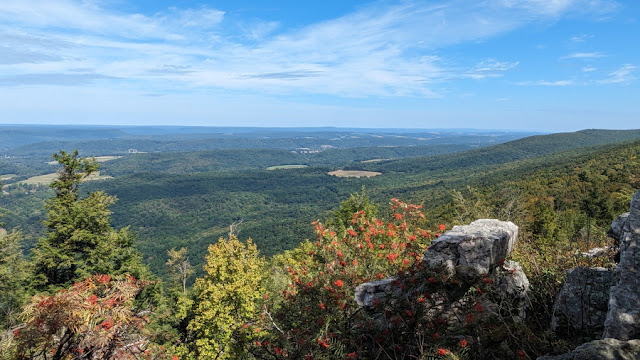This week was spent exploring Pennsylvania Dutch Country and the mid-Appalachian Mountain area. One of our excursions was a hike on Kittatinny Ridge to Hawk Mountain which is a raptor sanctuary. On the migration path for raptors, the sanctuary tallies 17 different species of raptor flying overhead, and the total count to date, only half way through the migration, is 8812. Unfortunately, the day we were there it was very slow. Early in the morning, before we arrived, a group of 181 broad-winged hawks flew over, but the whole rest of the day saw only 13 more birds. While we were at the summit we saw several turkey vultures, plus one peregrine falcon so far off in the distance that I couldn't convince myself I saw it. But we did get some good close looks at turkey vultures as they soared over the ridge.
 |
| They were all immature, thus the gray rather than red head. |
 |
| The view from the north summit where the count takes place. |
 |
| This is the south summit which has a fully accessible trail from the trailhead. |
I've noted a couple of times this fall the good mast year we're experiencing in New Hampshire with large crops of white pine, beech, and red oak mast, and the same seems to taking place in Pennsylvania. Wherever we went, branches and ground were well adorned with nuts of the region: hickory, chestnut, oak, black walnut, even locust.
 |
| Locust seed pods. |
I picked up a small bagful of black walnuts to find out just how palatable these wild nuts are and how they compare to English walnuts. It's a bit of a process to prepare them, something that gave me more appreciation for what it takes to bring commercial nuts to market as well as how much time and effort early inhabitants of North America put into harvesting food. First the thick outer skin needed to removed. This was easily accomplished by rolling them one at a time under my foot, which broke open the fruit to expose the nut.
The nut came out easily, but then the work began. There's a thick, stringy layer tightly adhered to the outside of the nut which needs to be completely removed or it will grow potentially harmful mold, and will ruin the taste of the nutmeat inside. This took a lot of scraping, scrubbing, and washing - with gloves on because the nuts have strong tannins that will stain your hands terribly. Once clean I put them in a mesh bag to thoroughly dry out.
 |
| Cleaned black walnuts |
After aging for several weeks to several months they'll be ready to sample, after another challenge. Store bought English walnuts are hard enough to crack, and black walnuts are even harder. It seems it's almost impossible to crack them without pulverizing the nutmeat inside even using special tools designed for this purpose. One technique I read about says to dry them until the shell cracks along the seam, and then pry it open with a knife. I'll report my experience with opening them as well as whether they taste good enough to warrant the effort.
This sycamore tree is in the Landis Valley near Lancaster. It's growing next to a circa 1900 hotel that's on the old Pennsylvania coach road and is now protected by the Landis Valley Museum.
Tulip poplar trees are common in the area - I saw many - and they are even bigger than sycamore, competing with white pine and eastern hemlock for the tallest trees in the east.
This one is growing along the Great Oak Trail at the Quittie Creek Nature Park in Anneville. Quittie Park was a disaster of an abandoned industrial site turned illegal dumping area. The town of Anneville committed to turn it into a park and it's now a model of town park with a pristine river running through it.
In addition to discovering nature, we also learned much of the local history and culture of the area from the original inhabitants of the valley to the Amish and Mennonite communities to the development of industries such as coal, iron, and yes, chocolate. Maybe some of that will get into future posts, but for now I'll just say the Amish have remarkable social, family, and work values, and their farms are beautiful.














No comments:
Post a Comment